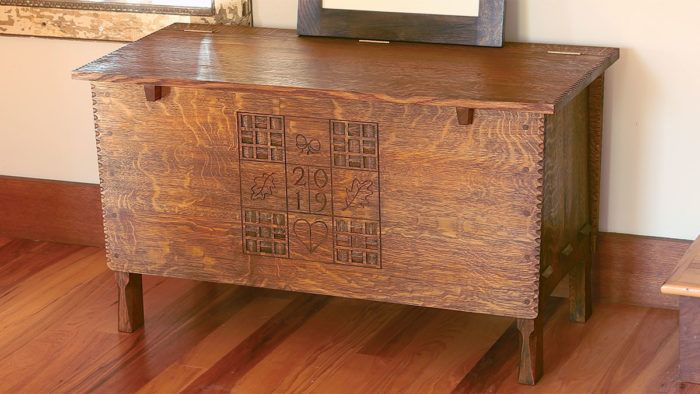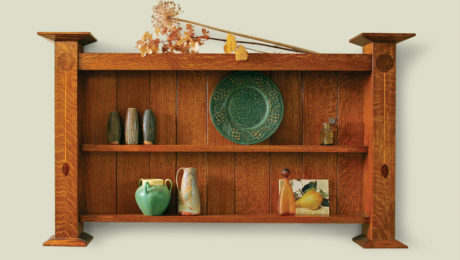Arts and Crafts Chest
Nancy Hiller builds a time-tested and versatile chest originally designed by Ernest Gimson.
Synopsis: A good example of the work of the Cotswold school of English Arts and Crafts Design, this chest has elegant lines, through-tenons, and decorative carvings. The unconventional joinery at first gave Nancy Hiller pause, but the vertical-grain sides, which fit into dadoes in the horizontal-grain front and back and are reinforced with pegs, have stood the test of time, not only in the original piece, but in the pieces she has made.
I’ve long been a fan of English designer Ernest Gimson (1864– 1919), who moved from London to the rural Cotswolds region with Sidney and Ernest Barnsley in 1893. Collectively their influential work, which is characterized by sturdy lines, exposed joinery, simple decorative carving, and motifs drawn from rural forms, is the heart of the Cotswold School of Arts and Crafts design.
This chest, or coffer, is a good example of the style. Built of quartersawn oak, it has straightforward lines, through-tenons, and artful lettering, along with decorative chamfers and gouging. It’s a versatile piece that would be equally at home storing towels in a bathroom or blankets at the foot of a bed.
Wondering what it’s like to go pro? Nancy Hiller
writes about the realities of being a professional
woodworker at Fine Woodworking’s Pro’s Corner.
Unconventional construction has lasted over a century

I was skeptical about the joinery. So I consulted Christopher Vickers, an English furniture maker who specializes in Arts and Crafts designs and has inspected the original chest at auction. Vertical-grain sides fit into dadoes in the horizontal grain front and back and are reinforced with pegs—rule breaking at its most blatant. But as Vickers points out, despite the opposing grain orientation, the front and back panels of the original coffer have not split. The quartersawn lumber no doubt helps; and though there are examples of other furniture forms made in quartersawn oak that have split where the joinery has not allowed for movement, splitting seems to be more likely in thinner stock. Because this cross-grain joinery is authentic to the original coffer, I’ve thrown caution to the wind and am using it here. The prototype chest I made a few years ago has made it through Indiana’s seasonal changes in temperature and humidity and is doing just fine.
Start with the sides and bottom
I begin the chest by cutting the sides to shape. Then I turn to the joinery that will attach the sides to the bottom. Through-tenons in the bottom fit into mortises in the sides. Lay out the mortises and score across the grain with a knife to avoid tearout. Remove the bulk of the waste with a drill, then chop out the rest and pare the edges with a chisel. Take care to avoid chopping or paring too vigorously and breaking out the grain on either face.
Click here to download Nancy’s
carving pattern from this chest.

From Fine Woodworking #281
To view the entire article, please click the View PDF button below.
 |
How To Build An Arts and Crafts Wall Shelfby Nancy Hiller |
 |
How To Build an Arts and Crafts Side Tableby Kelly Dunton |
 |
Arts and Crafts with an English Accentby Nancy Hiller |





















Comments
A wonderful build unfortunately wrecked at the end by brass hinges.
Log in or create an account to post a comment.
Sign up Log in